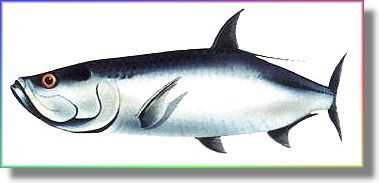
The 'Silver King.' Many a fisherman's first tarpon materializes as a smoking spool
and burning thumbs as the fish rips off line at incredible speeds and explodes the surface
like an ICBM launched from a submarine wearing a rhinestone suit. It is at this time, the
angler, with mouth open in awe, discovers the thrill of jumping a tarpon. If the angler has
done his job and has firmly set the hook in the cinder block hard jaw of the prehistoric
gamester, he is in for one of angling's greatest challenges. Every tarpon fisherman's
responsibility is to release every tarpon brought to the boat to guarantee the future of
the great "silver king", and offer future generations unforgettable thrills.
Tarpon are born in the sea as tiny, eel-like larvae. Females release almost 20 million
transparent larvae that must find their way to back to their tropical, ancestral home.
They undergo a unique transformation from bodiless leptocephalus into
silvery minnows that drift aimlessly to survive throughout the marine estuaries. As they
mature the silver darts grow into large headed small fish that are nurtured in lagoon mangroves.
They find protection and food among the roots and grasses, and make their homes in brackish
water, mosquito ditches and the canals of Florida's coastal areas. Some never return to the sea.
Here are some facts published by the Florida Marine Fisheries Department.
- Fossil research shows that tarpon have been swimming in our oceans since prehistoric times.
- Tarpon can reach sizes up to 8 feet and can weigh up to 280 pounds.
- The life span of tarpon can be in excess of 50 years.
- Due to its majestic appearance of size and color, the tarpon is nicknamed "silver king."
- Tarpon are primarily found in shallow coastal waters and estuaries, but they are also found in open marine waters, around coral reefs and in some freshwater lakes and rivers.
- Tarpon range from Virginia to central Brazil in the western Atlantic, along the coast of Africa in the eastern Atlantic, and all through the Gulf of Mexico and Caribbean Sea.
- Because of its strength, stamina, and fighting ability, the tarpon is one of Florida's premier game fish.
- Tarpon have a special ability to gulp air at the surface when they are in a habitat that doesn't provide enough oxygen.
- In their larval stage, Tarpon are transparent, have a ribbon-like body and prominent fanglike teeth, and are less than an inch long.
- Tarpon can only be fished recreationally in Florida. The majority of recreational anglers practice catch and release since the fish is not considered to be of any food value. However, anglers can possess them for trophy purposes at the cost of a special permit: limit - two per day.
- The state records for Tarpon are as follows:
- * conventional tackle - 243 pounds: Key West
Gus Bell: 2/17/1975
- * fly fishing tackle - 188 pounds: Homosassa Springs
William Pate, Jr.: 5/13/1982
In three years time baby tarpon have matured to 20 pounds, and are getting ready for
their next adventure. They start roaming the estuary, exploring and looking for bigger bait,
such as sand perch, eels, and finger mullet. Sometimes they venture back to the ocean.
One thing for certain, they hate hooks. They hate boats. They hate being handled.
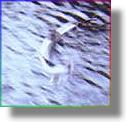
Baby 'POONs' are the 'rocket men' of the estuary, and are known for wild leaps, turns,
splash downs, long drives, and any antic to get away and get unhooked. Wiggling madly,
they do everything conceivable to avoid being handled. They are impossible to photograph,
even at shutter speeds near 2000. This baby tarpon on the right cleared the water by 3 feet.
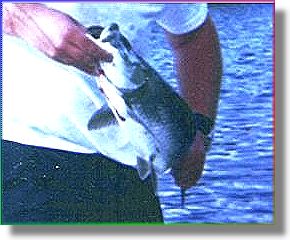 Todd Wynn, of Ormond Beach, steadies a 5-lb POON for the camera. Dennis O'Brien caught this
cutie on an 8-wt Loomis. Tarpon are veracious eaters and consume a wide variety of bait
including sand perch, eels, pigfish, pinfish, mullet, crabs and glass minnows. Baby tarpon
Todd Wynn, of Ormond Beach, steadies a 5-lb POON for the camera. Dennis O'Brien caught this
cutie on an 8-wt Loomis. Tarpon are veracious eaters and consume a wide variety of bait
including sand perch, eels, pigfish, pinfish, mullet, crabs and glass minnows. Baby tarpon
 are joiners and you can often see them parading around a basin in a Conga line one behind
the other. With Decorator Crabs, camouflage doesn't always work with tarpon. (Shown on
the right.)
are joiners and you can often see them parading around a basin in a Conga line one behind
the other. With Decorator Crabs, camouflage doesn't always work with tarpon. (Shown on
the right.)
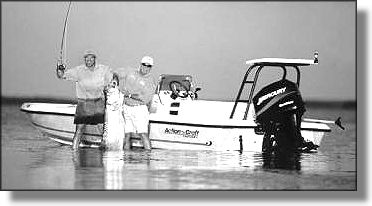
Once they have reached the 25 to 30 pound range their growth slows down to 1/3 inch per
month, unlike their redfish cousins that grow about an inch per month. It takes about
15 years for a Tarpon to reach 100 pounds. A six-foot tarpon can weigh anywhere
from 150 to 200 pounds and be 40 years old. Most tarpon over 100 pounds tend
to be females while the males top out at 65 to 90 pounds and stop growing after about
25 years. The females continue growing. One was netted off Hillsboro in the early
1900s that weighed about 350 pounds. The photo on the left are fly anglers from
Mercury Marine with a big POON.
Tarpon are the most sought after game fish on the planet. People have ruined their
lives and fortunes just to have a shot a catching one of these huge monsters. There is,
however, only one thing better than catching a 100-pound tarpon, and that's catching
a 'baby poon.' As noted, the baby poons are three or four years old, small enough
to be found in the estuary and big enough to get your heart pumping. They will spool
into your backing and put on a great fireworks show. The school or spawning baby
tarpon will move around in backwater creeks in small pods of 10 to 20 fish. They
sometimes daisy chain and you can witness this when you see glass minnows arched
in a ribbon of glass beads accelerating over the water. Baby tarpon mouths are wide
open, like milk jugs, they move into the minnows like gargoyles squirting water, running
on a track.
Hooking a 'baby poon' is another experience. Try holding a live hand-grenade. Be
sure you are rigged for the fight. Plan on having at least 200 yards of 20# braided Dacron
backing. You can use an 8wt rod or bigger. Sometimes it is better to bring a 10wt rod
just in case you hook into a 50 or 60-pound 'POON' that hasn't found the open
ocean all that appetizing.
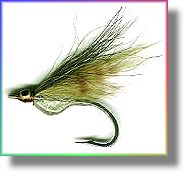
Use 12# to 20# tippets with 30# to 40# shock tippets. Fluorocarbon leaders work best.
Baby Tarpon can hit a large hair bug or small glass minnow. It depends on what they
are eating at the time. They will also hit a crab fly. Look at the bait. If you see large
mullet, use large water-pushing flies. If you see minnows, pilchards, or menhaden use a
glass minnow fly, Capt. Denny's Glass Minnow is shown on the right.
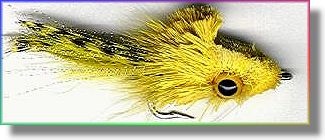 Color and shape are also important factors when considering what fly to use. During a
bright sunny day, don't throw a black fly. You will scare the fish. The best choice is
always chartreuse or yellow/white. Use small hooks, size 2 to 4. It is better to push
a pin through a brick than a nail. Flies that push water are great attention getters for Tarpon.
This bug is tied with a flared head, I call it 'o yeller.' The action in the water is outstanding.
Short 3 - strips are all that is needed.
Color and shape are also important factors when considering what fly to use. During a
bright sunny day, don't throw a black fly. You will scare the fish. The best choice is
always chartreuse or yellow/white. Use small hooks, size 2 to 4. It is better to push
a pin through a brick than a nail. Flies that push water are great attention getters for Tarpon.
This bug is tied with a flared head, I call it 'o yeller.' The action in the water is outstanding.
Short 3 - strips are all that is needed.
Be careful when you are tarpon fishing. In the late afternoon tarpon will hide under the
manatees, as my fishing party found out not long ago. Manatees are naturally curious
and will come over to your boat. Do not feed them. Manatees are protected in the State
of Florida. It is unlawful to harm them in any way. They can be attracted to trolling motors.
So when you are in a manatee area and you've picked your spot just turn off the trolling
motors.
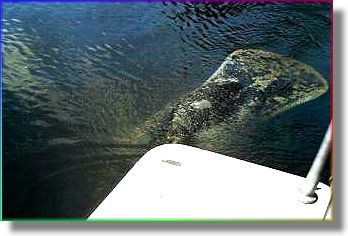 Here a manatee scratches his stomach on my Lenco Trolling Tabs. Another one is scratching
his back on my new keel guard. Five minutes later a mother and calf join with the rest. We
are completely surrounded and enjoy their antics for more than a half hour. Keep your yellow
fly line out of the water when manatees are near. They will eat the line. That's a horrible
way to loose your new Wonderline.
Here a manatee scratches his stomach on my Lenco Trolling Tabs. Another one is scratching
his back on my new keel guard. Five minutes later a mother and calf join with the rest. We
are completely surrounded and enjoy their antics for more than a half hour. Keep your yellow
fly line out of the water when manatees are near. They will eat the line. That's a horrible
way to loose your new Wonderline.
Make your plans well in advance and have an enjoyable day fishing for baby poon.
Take in all the beautiful scenery, too. Until next time, ~ Doug
Credits: Tarpon Drawing Courtesy of Roger Burleson, Hard Copy, Inc.
About Doug:
Doug is a USCG Licensed Captain and fly-fishing guide from New Smyrna Beach,
a member of CCA, FFF, AFF, APCA, FOWA, the Action Craft Saltwater Team,
and the Orvis and Redington Pro-Guide Program. He can be reached at 386-679-5814.
|



